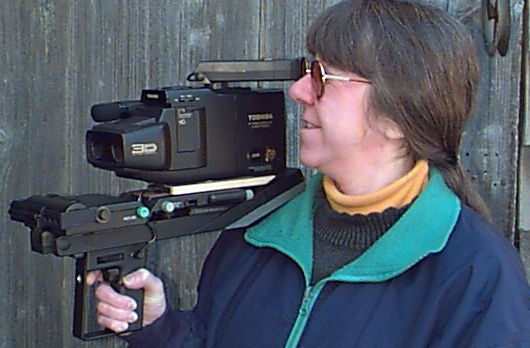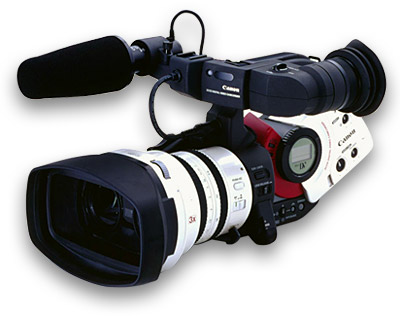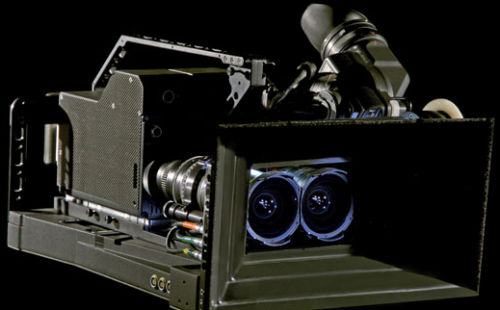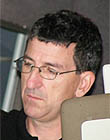|
|
This topic comprises 2 pages: 1 2
|
|
Author
|
Topic: Panasonic unveils world's first integrated full HD 3D camcorder at CES 2010
|
Jeremy Weigel
Phenomenal Film Handler

Posts: 1062
From: Edmond, OK, USA
Registered: Mar 2007
|
 posted 01-10-2010 01:05 AM
posted 01-10-2010 01:05 AM




Panasonic HD 3D Video Camera
quote:
PANASONIC UNVEILS WORLD’S FIRST INTEGRATED
FULL HD 3D CAMCORDER AT CES 2010
Available In Fall 2010 - Solid-State Recording System Will Offer
Highly-Efficient Full HD 3D Video Production
LAS VEGAS, NV (January 6, 2010) – Panasonic Corporation (NYSE: PC) will release the world’s first* professional, fully-integrated Full HD 3D camcorder in Fall 2010. The company will begin taking orders in April. Engineering samples of the professional Full HD 3D solid-state camcorder will be exhibited at the Panasonic booth (Las Vegas Convention Center, Main Hall, #9405) at the 2010 International CES in Las Vegas, USA, from January 7-10.
This Full HD 3D camcorder will offer the following core benefits:
Easier to Use
Current 3D systems are large-scale setups in which two cameras are fitted to a rig in parallel, or vertically intersect across a half-mirror. Separate recorders are also required. In Panasonic’s new Full HD 3D camcorder, the lenses, camera head, and a dual Memory Card recorder are integrated into a single, lightweight body. The camcorder also incorporates stereoscopic adjustment controls making it easier to use and operate.
The twin-lens system adopted in the camcorder’s optical section allows the convergence point** to be adjusted. Functions for automatically correcting horizontal and vertical displacement are also provided. Conventional 3D camera systems require these adjustments to be made by means of a PC or an external video processor. This new camcorder, however, will automatically recalibrate without any need for external equipment, allowing immediate 3D image capture.
More Flexible
The solid-state memory file-based recording system offers greater flexibility to produce Full HD 3D videos in more challenging shooting environments. The camcorder is lighter weight and smaller than current 3D rigs, while providing the flexibility of handheld-style shooting. Setup and transportation is simplified, making it ideal for sports, documentary and filmmaking projects.
Solid-State Reliability and Workflow
Right and left Full HD video streams of the twin-lens 3D camcorder can be recorded as files on SDHC/SD Memory Cards, ensuring higher reliability than on other tape, optical disc, HDD or other mechanical-based recording systems. This solid-state, no-moving-parts design will help significantly reduce maintenance costs, and the 3D camcorder will be better able to perform in extreme environments and be more resistant to temperature extremes, shock, and vibration.
And users will enjoy a fast, highly-productive file-based workflow, with instant, random access to recorded content; easy plug-in to both Mac and PC-based platforms; and longer recording capacity.
More Affordable
Using a standardized, fully integrated design, the Full HD 3D camcorder will be offered at a much lower price than traditional 3D rigs. Transportation expenses for this handheld unit will be less and faster setup times reduce labor costs. Using standard, re-recordable SDHC/SD Memory Cards available already everywhere, media costs become almost insignificant.
In addition to a camcorder, Panasonic also plans to offer a professional-quality 3D Full HD LCD monitor for field use as well as a professional HD digital AV mixer for live event production. Panasonic will offer professional production equipment to allow video professionals to efficiently create 3D content, so consumers can enjoy 3D video using Panasonic 3D home theater systems.
Major Specifications (tentative)
- Product Name: Twin-lens Full HD 3D camcorder (made-to-order)
- Suggested Retail Price for Main Unit: $21,000
- Available: Fall 2010 (made to order)
- Power Consumption: Under 19 W (main unit only)
- Weight: Under 3 kg (main unit only)
- Recording Media: SDHC/SD Memory Card
* As an integrated twin-lens Full HD 3D camcorder capable of recording Full HD 3D video to Memory Cards. As of January 2010 (based on our investigation)
** The point at which the left and right-camera lenses’ optical axes converge
Development Background
Movie companies and content producers are eager to produce more 3D content. 3D video is set to become a mainstream motion picture technology. In response to the resurgence of 3D movies, in September 2009, Panasonic proposed the world’s first 3D home theater systems, based around 3D-enabled Blu-ray Disc players and Plasma TVs (announced and exhibited at CEATEC 2008). In February 2009, the company established the Advanced Authoring Center (within Panasonic Hollywood Laboratory) – at which 3D movies are authored for replication on 3D Blu-ray Discs (announced at CES 2009). Currently, producing 3D movies is a painstaking process. Panasonic intends to promote the production of high-quality 3D video content by accelerating the development of 3D video production systems designed to boost production speed and efficiency.
Supplementary data:
Differences from conventional 3D camera systems:
Conventional 3D camera systems are built from two off-the-shelf film or broadcast cameras. Normally, the two cameras are installed horizontally and side by side, with the right and left camera axes approximately 6.5 cm apart – equivalent to the distance between the human eyes – to create binocular parallax. This can be done with small cameras, but broadcast or film cameras cannot be installed side by side since their bodies and lenses are too large. They must be installed vertically using half-mirrors, or mounted on metal frames called rigs, using prisms. This results in a bulky system that must be carefully adjusted to prevent the right and left cameras from going out of alignment before image capture. In addition, if the system is moved, the shock or vibration inevitably puts the cameras out of alignment, making frequent re-adjustment necessary.
In this fully-integrated Full HD 3D camcorder that Panasonic has developed, the two lenses, camera head, and memory card recorder are incorporated into a single compact housing. Unlike large 3D camera systems, this camcorder allows video shooting with greater mobility and from all angles; significantly reducing the time required for set up and adjustments, thereby leaving more time for creative activities.
Convergence Point Adjustment
The convergence point is the point at which the left and right cameras’ optical axes converge to produce 3D images. To take natural-looking 3D video, the convergence point needs to be adjusted to match that of a human’s eyes, whose convergence point varies according to the closeness of the objects being viewed. Panasonic’s new Full HD 3D camcorder adopts newly-developed twin-lens system that realizes convergence point control with its integrated design.
About Panasonic
Panasonic Corporation is a worldwide leader in the development and manufacture of electronic products for a wide range of consumer, business, and industrial needs. Based in Osaka, Japan, the company recorded consolidated net sales of 7.77 trillion yen (US$78.4 billion) for the year ended March 31, 2009. The company's shares are listed on the Tokyo, Osaka, Nagoya and New York (NYSE: PC) stock exchanges. For more information on the company and the Panasonic brand, visit the company's website at http://panasonic.net.
[ 01-20-2010, 10:29 AM: Message edited by: Mike Olpin ]
| IP: Logged
|
|
|
|
|
|
|
|
|
|
|
|
|
|
|
|
Julio Roberto
Jedi Master Film Handler
Posts: 938
From: Madrid, Madrid, Spain
Registered: Oct 2008
|
 posted 01-10-2010 01:36 PM
posted 01-10-2010 01:36 PM



quote: Joe Redifer
Julio, 80mbps is too slow. Panasonic's P2 cards do over 100mbps and they are too slow.
Well, as I said, current SD cards in the market, like the 8GB SanDisk Extreme III, can do 152Mb/s sustained (240Mb/s peak).
quote: Joe Redifer
Remember, we are capturing video, not playing it back. Each frame must be its own individual entity which cannot happen if it is captured in MPEG4 or similar form. When it is captured as MPEG4 or some wimpy variety thereof, the video is destroyed before it can be edited because only the differences between the frames are stored. Very cheesy.
Well, while ideally each frame should have its own independent space if you have the bandwidth and don't mind the storage waste, this doesn't (necessarily) "destroy" the video or anything like that. Simply makes the editing a lot more computer intensive to do natively and limits a bit your options to do native-compressed editing. But if you are editing lossless or transcoding the final result anyway (say to blu-ray, another HD format for broadcast, etc), then ...
quote: Joe Redifer
With two independent "full HD" (god I hate that term) streams, one would need at least 200mbps to adequately capture it all and keep it in a non-destructive and easily editable form.
Well, if you insist in intraframe compression only, and don't even want to use the redundancies between a stereo frame pair (left/right pair), I'd say a bit less is fine nowadays. Even if P2 is doing 100Mb/s, it's only because DVCPRO is NOT the best intraframe-only codec available today.
quote: Joe Redifer
I'm pretty sure DCI exceeds 31mbps, especially with sound.
As I said, DCI is 31MBps (Uppercase "B") for the image. Quoting myself:
quote:
For comparison, DCI 3D cinema image ... ... peaks at 31MB/s.
The sound is additional.
Which is the same as saying 250Mb/s. Remember there are in the market TODAY SD cards that obtain 240Mb/s peak, even if they fall a bit short in sustained recording.
So yeah. SD cards are "up there" already. Of course, newer and faster ones are bound to appear anytime soon in time for Panasonic's 3D camera ![[Wink]](wink.gif)
And those cameras will use AVC-ULTRA encoding, so figure they need under 80Mbs (10MB/s) to do fine with two HD streams at up to 30fps, even if their codec tops at above 200Mbs. That's totally surpassed with plenty of SD cards in the market.
http://blog.panasonic-broadcast.com/2009/04/avc-ultra/
| IP: Logged
|
|
|
|
Joe Redifer
You need a beating today

Posts: 12859
From: Denver, Colorado
Registered: May 99
|
 posted 01-10-2010 05:48 PM
posted 01-10-2010 05:48 PM





Julio, your standards must be very low.
quote: Julio Roberto
Well, as I said, current SD cards in the market, like the 8GB SanDisk Extreme III, can do 152Mb/s sustained (240Mb/s peak).
No, you did not say that. It must be able to WRITE that fast sustained, not read. I have yet to see any flash media type that can write as fast as it can read. I have an Extreme 3 card and it maxes out around 30mbps. So I guess "Extreme 3" means jack shit if there are different versions of extremity.
quote: Julio Roberto
As I said, DCI is 31MBps (Uppercase "B") for the image.
Then why do you even compare with DCI? DCI wipes the floor with any home format. It is compressed for quality. I'll take quality over space savings any day of the week... twice on Sundays! I don't consider bigger codecs a waste of space at all. 4:4:4 is da phiggidy phat bomb.
AVC Ultra may be better than normal AVC, but each frame still does not exist independently. That is fine for a delivery format but not for a capture format.
| IP: Logged
|
|
|
|
Julio Roberto
Jedi Master Film Handler
Posts: 938
From: Madrid, Madrid, Spain
Registered: Oct 2008
|
 posted 01-10-2010 09:10 PM
posted 01-10-2010 09:10 PM



quote: Joe Redifer
No, you did not say that. It must be able to WRITE that fast sustained, not read.
Of course, Joe, I meant indeed WRITE at those SUSTAINED speeds. Read performance is EVEN FASTER (but not by much). It was MEASURED AND TESTED, not by me, but by a guy online that is a pro.
Here is an example:
http://www.robgalbraith.com/bins/camera_multi_page.asp?cid=6007-9597
quote: Bobby Henderson
Simply put, Joe is talking about professional standards of videography. Professional standards dictate ways to deliver a full UNCOMPRESSSED video stream via outputs like HD-SDI.
Well, Bobby, sorry to burst the bubble but virtually no video camera used in adquisition, especially the models most used to SHOOT THE MOVIES YOU SEE IN CINEMAS, records uncompressed, much less to HD-SDI, which is very limited.
They record stuff like COMPRESSED 4K RAW or any other variation. Some are starting to show up that record COMPRESSED 4:4:4 HD.
Typically, everybody in TV records COMPRESSED 4:2:2 HD. More and more using interframe compressed. And these are PROFESSIONALS. Uncompressed recording is basically only used to transfer stuff from one place to another or sometimes for editing. But even then, lossless compression is mostly used instead.
quote: Joe Redifer
AVC Ultra may be better than normal AVC, but each frame still does not exist independently. That is fine for a delivery format but not for a capture format.
Joe: AVC has an intraframe-only compression mode were each frame indeed "lives independently", in both, 4:2:2 and 4:4:4. And a lossless one too, BTW. AVC-ULTRA even has a 12 bits 4:4:4 mode.
Sorry to refer to wikipedia, but it's fast and convinient. If you have doubts, you can find the specs yourself I'm sure.
http://en.wikipedia.org/wiki/H.264/MPEG-4_AVC
You guys are too fixated, and wrongly IMHO, with the following:
-Somehow, capturing with interframe redundancies removed MUST destroy the quality. This is NOT true at all. Only if the bandwidth is too small to produce a decent frame individually, can some scene suffer. A 100Mbps AVC-ULTRA interframe compressed stream is ALWAYS *vastly* superior in quality to a 100Mbps intraframe only codec. Agree?
-An interframe compressed captured video can not be "professional". This notion comes from the inability to flexibly edit it natively. But if you are editing it, you don't have to (or usually want to) do it natively if you are a true professional. Nobody hands over a final product in DVCPRO 100Mbps on a P2 card. You have to transcode just about ALL capture formats into something the network/cinema/DVD/blu-ray will take or the movie industry wants. As a result, 99% of the time you transcode to lossless or your favorite lossy editing format and transcode again to your final format. Tell me a workflow that is NOT recompresses from adquisition to DELIVERY and that, according to you, is better in quality to say 80mbps AVC-intra. I won't even ask for one that is uncompressed "HD-SDI" because I don't think there is any used beyond especial effects units in video studios.
Intra adquisition stopped being a "absolute professional requirement" when professionals stopped using the DV format. Now its a DESIRABLE feature, so you don't have to transcode and can keep the original edit in the original form, but this form is at most 4:2:2 XDCAM or some "crap".
But if you don't think that Panasonic's new $23.000 3-D camera is suitable for "for professional use", or the 34Mbps Canon 5D Mark II (which has been used in plenty of TV commercials and even TV programs and indie motion pictures), well, suit yourself. But you better start finding some FAST, really FAT memory format to put all those MBPS and hope they aren't too expensive if you want to become "video" professionals ![[Wink]](wink.gif)
| IP: Logged
|
|
|
|
Julio Roberto
Jedi Master Film Handler
Posts: 938
From: Madrid, Madrid, Spain
Registered: Oct 2008
|
 posted 01-10-2010 10:05 PM
posted 01-10-2010 10:05 PM



Uncompressed HD-SDI origination only happens in a couple of situations. Well, mostly.
One is when the camera in use is REALLY CHEAP compared with alternatives, but the quality is seriously compromised by the recording format. Then you "hack" the stuff. But you don't shoot a "newscast" piece, or a sport events that way. At least not 99.99% of the time.
The second situation where you such set ups are common is in special effects work. For technical reasons.
The third would be some Live TV show in a studio. Goes straight from the camera to the editing to the air. It is compressed to store in tape, though.
And little more.
Originating formats are almost always compressed. And the "higher the quality", the "more compressed", as it must fit somewhere *fast* and flash memory is nor *that* cheap nor *that* fast, although it's getting there quickly.
RED one, the camera most used for digital adquisition for TV shows and movies today, i.e., until recently used ONLY 28MBS and it recorded RAW 4K 4:4:4 12 bits up to 30fps!!!!
quote:
Two variants were offered previously, one with a maximum data rate of 28 MB/s (224 megabits), and one with a maximum data rate of 36 MB/s (288 megabits), but the camera was recently updated to record with an additional data rate option of 42 MB/s (336 megabits).
This is the camera used to shoot many of the movies you see on the big screen as well as the series you see on the TV today.
And you are complaining that the new Panasonic 3D camera, which may top at 25MB/s (guessing) but only does HD 4:2:2 8 bits (I think) "60fps" (but using stereo-pair compression, I'm guessing from the announcements), is "not professional by any means" because it uses SD memory cards ![[Roll Eyes]](rolleyes.gif)
BTW, I guess you knew that the P2 cards used by "professionals" were nothing but 4 SD memory cards inside in a RAID configuration ![[Big Grin]](biggrin.gif) Since then, some SD cards have increased in performance quite a bit. And AVC, even intra mode, kicks the butt off DVCPRO, reducing the need for bandwidth while KEEPING THE SAME QUALITY ... Since then, some SD cards have increased in performance quite a bit. And AVC, even intra mode, kicks the butt off DVCPRO, reducing the need for bandwidth while KEEPING THE SAME QUALITY ...
| IP: Logged
|
|
|
|
All times are Central (GMT -6:00)
|
This topic comprises 2 pages: 1 2
|
Powered by Infopop Corporation
UBB.classicTM
6.3.1.2
The Film-Tech Forums are designed for various members related to the cinema industry to express their opinions, viewpoints and testimonials on various products, services and events based upon speculation, personal knowledge and factual information through use, therefore all views represented here allow no liability upon the publishers of this web site and the owners of said views assume no liability for any ill will resulting from these postings. The posts made here are for educational as well as entertainment purposes and as such anyone viewing this portion of the website must accept these views as statements of the author of that opinion
and agrees to release the authors from any and all liability.
|

 Home
Home
 Products
Products
 Store
Store
 Forum
Forum
 Warehouse
Warehouse
 Contact Us
Contact Us




 Printer-friendly view of this topic
Printer-friendly view of this topic







![[Wink]](wink.gif) ) for a while now. Plus there's been SD cards in the market for a while that sustain close to 19MB/s in practice (peak at 22MB/s).
) for a while now. Plus there's been SD cards in the market for a while that sustain close to 19MB/s in practice (peak at 22MB/s).






![[Roll Eyes]](rolleyes.gif)
![[Big Grin]](biggrin.gif) Since then, some SD cards have increased in performance quite a bit. And AVC, even intra mode, kicks the butt off DVCPRO, reducing the need for bandwidth while KEEPING THE SAME QUALITY ...
Since then, some SD cards have increased in performance quite a bit. And AVC, even intra mode, kicks the butt off DVCPRO, reducing the need for bandwidth while KEEPING THE SAME QUALITY ...



